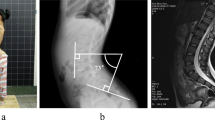Summary
The diagnosis of tethered cord syndrome (TCS) without typical conus medullaris symptoms and the radiological features such as a low set conus medullaris or dysraphic malformation is difficult. We report 11 year old identical twin brothers with TCS associated with the conus at the normal level. Their presenting symptom was progressive leg pain and both patients underwent surgical interruption of the filum terminale. The pain recurred in one patient treated surgically only after symptom became worse but resolved immediately in the other sibling treated promptly. We indicate the importance of early diagnosis and treatment of TCS to obtain excellent long-term outcome despite the absence of a low set conus or specific symptoms. Furthermore, when a twin or sibling of an affected person has neurological symptoms and the cutaneous signature of spinal dysraphism, radiological examination should be performed to establish the cause.



Similar content being viewed by others
References
Brown E, Matthes JC, Bazan C 3rd, Jinkins JR (1994) Prevalence of incidental intraspinal lipoma of the lumbosacral spine as determined by MRI. Spine 19:833–836
Bulsara KR, Zomorodi AR, Enterline DS, George TM (2004) The value of magnetic resonance imaging in the evaluation of fatty filum terminale. Neurosurgery 54:375–379
Coulier B, Mailleux P (1994) [Lipoma of the filum terminale: a prospective tomodensitometry study]. J Belge Radiol 77:116–118
Kannu P, Furneaux C, Aftimos S (2005) Familial lipomyelomeningocele: a further report. Am J Med Genet A 132:90–92
Little J, Nevin NC (1989) Congenital anomalies in twins in Northern Ireland. II: neural tube defects, 1974–1979. Acta Genet Med Gemellol (Roma) 38:17–25
Okumura R, Minami S, Asato R, Konishi J (1990) Fatty filum terminale: assessment with MR imaging. J Comput Assist Tomogr 14:571–573
Saito Y, Koba T, Itoh H, Miwa T, Tsuji K (1993) [Immunogenetic studies of spina bifida—sibling cases in three families]. No To Hattatsu 25:417–422
Selcuki M, Coskun K (1998) Management of tight filum terminale syndrome with special emphasis on normal level conus medullaris (NLCM). Surg Neurol 50:318–322
Van der Meulen WD, Hoving EW, Staal-Schreinemacher A, Begeer JH (2002) Analysis of different treatment modalities of tethered cord syndrome. Childs Nerv Syst 18:513–517
Warder DE, Oakes WJ (1994) Tethered cord syndrome: the low-lying and normally positioned conus. Neurosurgery 34:597–600
Yamada S (2004) Tethered cord syndrome in adults and children. Neurol Res 26:717–718
Yamada S, Knerium DS, Mandybur GM, Schultz RL, Yamada BS (2004) Pathophysiology of tethered cord syndrome and other complex factors. Neurol Res 26:722–726
Yamada S, Won DJ, Siddiqi J, Yamada SM (2004) Tethered cord syndrome: overview of diagnosis and treatment. Neurol Res 26:719–721
Yundt KD, Park TS, Kaufman BA (1997) Normal diameter of filum terminale in children: in vivo measurement. Pediatr Neurosurg 27:257–259
Author information
Authors and Affiliations
Corresponding author
Additional information
Comment
This is a short report of tethered cord syndrome in a pair of identical twins. Dysraphic and paradysraphic malformations in identical and non-identical twins, and among non-twin siblings, have been well recognized. Their occurrences are considerably more common than might be inferred from the paucity of published reports. The malformations in each twin or sibling may be identical, as in this case (filum–filum), or different, e.g., split cord malformation (SCM)–lipoma, transitional lipoma–dorsal lipoma, lipoma–filum, or SCM–filum. If a twin or sibling of an affected person has compatible symptoms or cutaneous signature of spinal dysraphism, he or she should have an MRI, as the authors emphasized.
The location of the conus has not been refuted as an important indicator of cord tethering, so the authors’ point in this regard is well taken. Certainly, the presence of a fatty filum in face of unrelenting leg pain is a sound reason for surgery.
The leg pain in patient 1 is highly characteristic of chronic central pain. It is well known central pain of spinal cord origin takes a long time to recede after relief of the cause. Thus, this child’s arduous course is understandable.
Tethered cord syndrome in twin and non-twin siblings is relatively rare and this report is thus of important archival value.
Dachling Pang
University of California, Davis
Rights and permissions
About this article
Cite this article
Mitsuka, K., Horikoshi, T., Watanabe, A. et al. Tethered cord syndrome in identical twins. Acta Neurochir (Wien) 151, 85–88 (2009). https://doi.org/10.1007/s00701-008-0170-8
Received:
Accepted:
Published:
Issue Date:
DOI: https://doi.org/10.1007/s00701-008-0170-8




